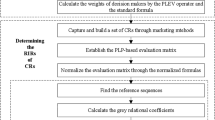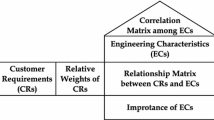Abstract
Quality function deployment (QFD) is a method commonly used in manufacturing industries to identify customer requirements (CRs) and the manufacturing capacity to meet CRs. Importance rate (IR) of CRs plays an important role in the QFD method. The existing methods in determining IR of CRs cannot consider all related factors of customer satisfaction, need importance, personal information, and relationship between customer satisfaction and function implementation. This paper proposes a method to improve the IR accuracy. Based on comments of customers for a product, importance rates of CRs are defined using integrated importance-performance analysis (IPA) and Kano models. IPA and Kano models are integrated by spectral clustering where a similarity matrix W is formed to balance the influence proportion between the IPA and Kano models considering comments of different customers for the product. IR of CRs is used in the QFD method to define functions and structures of the product. The proposed method is compared with several existing methods in case studies of designing an upper limb rehabilitation device and a feed drive system of the CNC machine. Results show that the proposed method has improved accuracy of IR of CRs for the product design and manufacturing.





Similar content being viewed by others
References
Jin J, Liu Y, Ji P, Liu H (2016) Understanding big consumer opinion data for market-driven product design. Int J Prod Res 54(10):3019–3041. https://doi.org/10.1080/00207543.2016.1154208
Sousa-Zomer TT, Miguel PAC (2017) A QFD-based approach to support sustainable product-service systems conceptual design. Int J Adv Manuf Technol 88(1–4):701–717. https://doi.org/10.1007/s00170-016-8809-8
Alinezad A, Seif A, Esfandiari N (2013) Supplier evaluation and selection with QFD and FAHP in a pharmaceutical company. Int J Adv Manuf Technol 68(1–4):355–364. https://doi.org/10.1007/s00170-013-4733-3
Madzík P (2018) Increasing accuracy of the Kano model–a case study. Total Qual Manag Bus Excell 29(3–4):387–409. https://doi.org/10.1080/14783363.2016.1194197
Parezanović T, Petrović M, Bojković N, Pamučar D (2019) One approach to evaluate the influence of engineering characteristics in QFD method. Eur J Ind Eng 13(3):299–331. https://doi.org/10.1504/EJIE.2019.100013
Chong YT, Chen CH (2010) Customer needs as moving targets of product development: a review. Int J Adv Manuf Technol 48(1–4):395–406. https://doi.org/10.1007/s00170-009-2282-6
Büyüközkan G, Ertay T, Kahraman C, Ruan D (2004) Determining the importance weights for the design requirements in the house of quality using the fuzzy analytic network approach. Int J Intell Syst 19(5):443–461. https://doi.org/10.1002/int.20006
Franceschini F, Galetto M, Maisano D, Mastrogiacomo L (2015) Prioritisation of engineering characteristics in QFD in the case of customer requirements orderings. Int J Prod Res 53(13):3975–3988. https://doi.org/10.1080/00207543.2014.980457
Bi JW, Liu Y, Fan ZP, Cambria E (2019) Modelling customer satisfaction from online reviews using ensemble neural network and effect-based Kano model. Int J Prod Res:1–21. https://doi.org/10.1080/00207543.2019.1574989
Chaudha A, Jain R, Singh AR, Mishra PK (2011) Integration of Kano’s model into quality function deployment (QFD). Int J Adv Manuf Technol 53(5–8):689–698. https://doi.org/10.1007/s00170-010-2867-0
Yadav HC, Jain R, Singh AR, Mishra PK (2013) Aesthetical design of a car profile: a Kano model-based hybrid approach. Int J Adv Manuf Technol 67(9–12):2137–2155. https://doi.org/10.1007/s00170-012-4636-8
Zhou Q, He L (2017) Research on customer satisfaction evaluation method for individualized customized products. Int J Adv Manuf Technol:1–10. https://doi.org/10.1007/s00170-017-1192-2
Deng WJ, Chen WC, Pei W (2008) Back-propagation neural network based importance–performance analysis for determining critical service attributes. Expert Syst Appl 34(2):1115–1125. https://doi.org/10.1016/j.eswa.2006.12.016
Kuo YF, Chen JY, Deng WJ (2012) IPA–Kano model: a new tool for categorising and diagnosing service quality attributes. Total Qual Manag Bus Excell 23(7–8):731–748. https://doi.org/10.1080/14783363.2011.637811
Mikulić J, Prebežac D (2016) The Kano model in tourism research: a critical note. Ann Tour Res 61:25–27. https://doi.org/10.1016/j.annals.2016.07.014
Wu HH, Tang YT, Shyu JW (2010) An integrated approach of Kanos model and importance-performance analysis in identifying key success factors. Afr J Bus Manag 4(15):3238–3250
Tontini G, Picolo JD (2014) Identifying the impact of incremental innovations on customer satisfaction using a fusion method between importance-performance analysis and Kano model. Int J Qual Reliab Manag. https://doi.org/10.1108/IJQRM-05-2012-0062
Deng WJ, Kuo YF, Chen WC (2008) Revised importance–performance analysis: three-factor theory and benchmarking. Serv Ind J 28(1):37–51. https://doi.org/10.1080/02642060701725412
Yin J, Cao XJ, Huang X, Cao X (2016) Applying the IPA–Kano model to examine environmental correlates of residential satisfaction: a case study of Xi’an. Habitat Int 53:461–472. https://doi.org/10.1016/j.habitatint.2015.12.013
Pai FY, Yeh TM, Tang CY (2018) Classifying restaurant service quality attributes by using Kano model and IPA approach. Total Qual Manag Bus Excell 29(3–4):301–328. https://doi.org/10.1080/14783363.2016.1184082
Wang CH, Fong HY (2016) Integrating fuzzy Kano model with importance-performance analysis to identify the key determinants of customer retention for airline services. J Ind Prod Eng 33(7):450–458. https://doi.org/10.1080/21681015.2016.1155668
Liu Y, Zhang Z, Liu Z (2011) Customized configuration for hierarchical products: component clustering and optimization with PSO. Int J Adv Manuf Technol 57(9–12):1223–1233. https://doi.org/10.1007/s00170-011-3346-y
Liu HT (2009) The extension of fuzzy QFD: from product planning to part deployment. Expert Syst Appl 36(8):11131–11144. https://doi.org/10.1016/j.eswa.2009.02.070
Ning W, Ji-chao X, Yu-fan W (2012) Integrated approach of quality function deployment to quality assurance of service products design. In 2011 International Conference on Computer And Management (CAMAN). https://doi.org/10.1109/CAMAN.2011.5778891
Chan KY, Kwong CK, Hu BQ (2012) Market segmentation and ideal point identification for new product design using fuzzy data compression and fuzzy clustering methods. Appl Soft Comput 12(4):1371–1378. https://doi.org/10.1016/j.asoc.2011.11.026
Alvandi M, Fazli S, Abdoli FS (2012) K-mean clustering method for analysis customer lifetime value with LRFM relationship model in banking services. Int Res J Appl Basic Sci 3(11):2294–2302
Ho GT, Ip WH, Lee CKM, Mou WL (2012) Customer grouping for better resources allocation using GA based clustering technique. Expert Syst Appl 39(2):1979–1987. https://doi.org/10.1016/j.eswa.2011.08.045
Wang H, Huo D, Huang J, Xu Y, Yan L, Sun W, Li X (2010) An approach for improving K-means algorithm on market segmentation. In 2010 International Conference on System Science and Engineering (pp. 368-372). IEEE. https://doi.org/10.1109/ICSSE.2010.5551709
Wu RS, Chou PH (2011) Customer segmentation of multiple category data in e-commerce using a soft-clustering approach. Electron Commer Res Appl 10(3):331–341. https://doi.org/10.1016/j.elerap.2010.11.002
Sagar S, Lundberg L, Skold L, Sidorova J (2017, June) Trajectory segmentation for a recommendation module of a customer relationship management system. In 2017 IEEE International Conference on Internet of Things (iThings) and IEEE Green Computing and Communications (GreenCom) and IEEE Cyber, Physical and Social Computing (CPSCom) and IEEE Smart Data (SmartData) (pp. 1150-1155). IEEE. https://doi.org/10.1109/iThings-GreenCom-CPSCom-SmartData.2017.177
Chang EC, Huang SC, Wu HH, Lo, CF (2007) A case study of applying spectral clustering technique in the value analysis of an outfitter’s customer database. In 2007 IEEE international conference on industrial engineering and engineering management (pp. 1743-1746). IEEE. https://doi.org/10.1109/IEEM.2007.4419491
Maciejasz P, Eschweiler J, Gerlach-Hahn K, Jansen-Troy A, Leonhardt S (2014) A survey on robotic devices for upper limb rehabilitation. J Neuroeng Rehabil 11(1):3. https://doi.org/10.1186/1743-0003-11-3
Mickaël C, Bernard A (2012) 3D ISO manufacturing specifications with vectorial representation of tolerance zones. Int J Adv Manuf Technol 60(5–8):577–588. https://doi.org/10.1007/s00170-011-3638-2
Funding
The authors wish to acknowledge that this research has been supported by the Discovery Grants (RGPIN-2015-04173) from the Natural Sciences and Engineering Research Council (NSERC) of Canada, University of Manitoba Graduate Fellowship (UMGF) and the Graduate Enhancement of Tri-Council Stipends (GETS) program from the University of Manitoba.
Author information
Authors and Affiliations
Corresponding author
Additional information
Publisher’s note
Springer Nature remains neutral with regard to jurisdictional claims in published maps and institutional affiliations.
Rights and permissions
About this article
Cite this article
Shi, Y., Peng, Q. A spectral clustering method to improve importance rating accuracy of customer requirements in QFD. Int J Adv Manuf Technol 107, 2579–2596 (2020). https://doi.org/10.1007/s00170-020-05204-1
Received:
Accepted:
Published:
Issue Date:
DOI: https://doi.org/10.1007/s00170-020-05204-1




